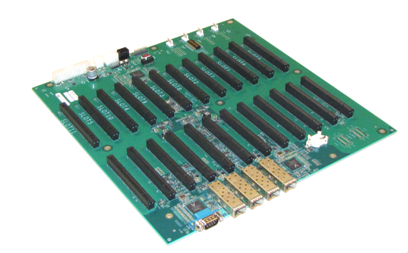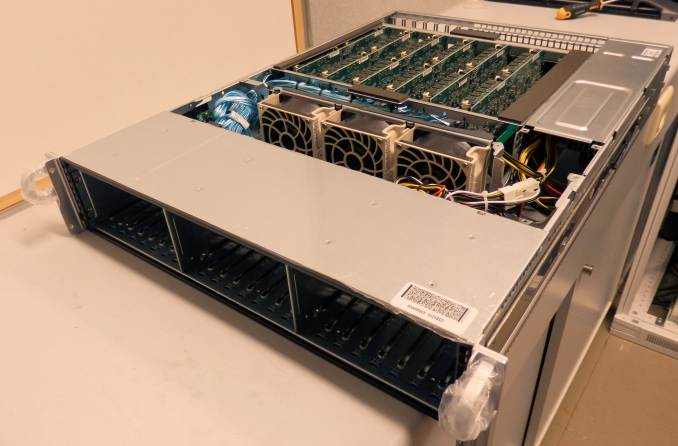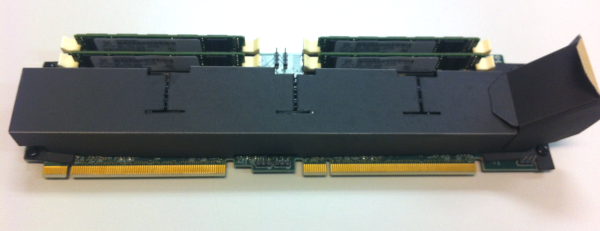Calxeda's ARM server tested
by Johan De Gelas on March 12, 2013 7:14 PM EST- Posted in
- IT Computing
- Arm
- Xeon
- Boston
- Calxeda
- server
- Enterprise CPUs
It's a Cluster, Not a Server
When unpacking our Boston Viridis server, the first thing that stood out is the bright red front panel. That is Boston's way of telling us that we have the "Cloud Appliance" edition. The model with an orange bezel is intended to serve as a NAS appliance, purple stands for "web farm", and blue is more suited for a Hadoop cluster. Another observation is that the chassis looks similar to recent SuperMicro servers; it is indeed a bare bones system filled with Calxeda hardware.
Behind the front panel we find 24 2.5” drive bays, which can be fitted with SATA disks. If we take a look at the back, we can find a standard 750W 80 Plus Gold PSU, a serial port, and four SFP connectors. Those connectors are each capable of 10Gbit speeds, using copper and/or fiber SFP(+) transceivers.
When we open up the chassis, we find somewhat less standard hardware. Mounted on the bottom is what you might call the motherboard, a large, mostly-empty PCB that contains the shared Ethernet components and a number of PCIe slots.

The 10Gb Ethernet Media Access Controller (MAC) is provided on the EnergyCore SoC, but in order to allow every node to communicate via the SFP ports, each node forwards its Ethernet traffic to one of the first four cards (the cards in slots 0-3). These nodes are connected via a XAUI interface to one of the two Vitesse VSC8488 XAUI-to-serial transceivers that in turn control two SFP modules each. Hidden behind an air duct is a Xilinx Spartan-6 FPGA, configured to act as chassis manager.
Each pair of PCIe slots contains what turns this chassis into a server cluster: an EnergyCard (EC). Each EnergyCard contains four SoCs, each with one DIMM slot. An EnergyCard contains thus four server nodes, with each node running on a quad-core ARM CPU.
The chassis can hold as many as 12 EnergyCards, so currently up to 48 server nodes. That limit is only imposed by physical space constraints, as the fabric supports up to 4096 nodes, leaving the potential for significant expansion if Calxeda maintains backwards compatibility with their existing ECs.
The system we received can only hold 6 ECs; one EnergyCard slot is lost because of the SATA cabling, giving us six ECs with four server nodes each, or 24 server nodes in total. Some creative effort has been made to provide air baffles that direct the air through the heat sinks on the ARM chips.
The air baffles are made of a finicky plastic-coated paper, glued to gether and placed on the EC with plastic nails, making it difficult to remove them from an EC by hand. Each EC can be freely placed on the motherboard, with the exception of the Slot 0 card that needs a smaller baffle.
Every EnergyCard is thus fitted with four EnergyCore SoCs, each having access to one miniDIMM slot and four SATA connectors. In our configuration each miniDIMM slot was populated with a Netlist 4GB low-voltage (1.35V instead of 1.5V) ECC PC3L-10600W-9-10-ZZ DIMM. Every SoC provided was hooked up to a Samsung 256GB SSD (MZ7PC256HAFU, comparable to Samsung’s 310 Series consumer SSDs), filling up every disk slot in the chassis. We removed those SSDs and used our iSCSI SAN to boot the server nodes. This way it was easier to compare the system's power consumption with other servers.
Previous EC versions had a microSD slot per node at the back, but in our version it has been removed. The cards are topology-agnostic; each node is able to determine where it is placed. This enables you to address and manage nodes based on their position in the system.














99 Comments
View All Comments
Madpacket - Wednesday, March 13, 2013 - link
And all of a sudden AMD's acquisition of SeaMicro is starting to make sense. Thanks Johan, great article!JohanAnandtech - Wednesday, March 13, 2013 - link
I really really hope they downscale the current SeaMicro's soon. Because with a starting price at $139000, they are not catering to the typical SME :-).joshv - Wednesday, March 13, 2013 - link
It seems this has a very narrow application in VM hosting, but I am not sure it's applicable when you have the choice of just scaling up memory or process usage of the single instance Xeon server. For example, I could load 24 instances of my production middle tier on the ARM server - or I could run one instance on a Xeon server and give it all the memory and make sure it spawns enough threads to keep all the internal cores busy. Perhaps my middle tier software has issues with handling all that RAM, so maybe I run 4 instances of it as a process, not a biggy.I am going to bet that the Xeon server will win as it won't have the VM overhead.
Kurge - Wednesday, March 13, 2013 - link
I would be interested in a bare metal comparison. Since you're serving up the same app why would you split it between 24 VMs on the Xeon server? It's a bit contrived.Just load up Server 2012 and IIS or Linux + Apache straight up on the Xeon and see how it performs.
MrSpadge - Wednesday, March 13, 2013 - link
Very interesting!I'd prefer a fat machine with virtualized servers to get automatic load balancing, but it's not like one couldn't shuffle tasks around in the ARM farm. And there's room for improvement: be it the next Atom or the memory controller in the current ECX-1000 CPUs. And take a look at how badly they scale from 2 to 4 threads - surely, there's lot's of rooms left!
rubyl - Wednesday, March 13, 2013 - link
What is the average CPU utilization for the Viridis nodes and for the Xeon system under the 5 different concurrency loads (for the 24 webserver workload)?gercho - Wednesday, March 13, 2013 - link
When you said " The next generation ARM servers are already on the way and will probably hit the market in the third quarter of this year. The "Midway" SoC is based on a 28nm (TSMC) Cortex-A15 chip. A 28nm A15 offers 50% higher single-threaded integer performance at slightly higher power levels and can address up to 16GB of RAM." As far as I know the A15 cores have 50% more performance but consume 3X more power, that's not "slightly".........nofumble62 - Wednesday, March 13, 2013 - link
50% more performance at 3X more power... reminding me of the Netburst architect.thenewguy617 - Wednesday, March 13, 2013 - link
Can you please point me to sources of your number?Thanks
Wilco1 - Thursday, March 14, 2013 - link
Where on earth you do get that 3x from? So far no 28nm Cortex-A15 chips have been released. The A15 in the Exynos Octo uses about 1.25W per core at 1.8GHz according to Samsung. That's slightly more power than a Calxeda A9 uses per core, but the A15 gives twice the performance per core.